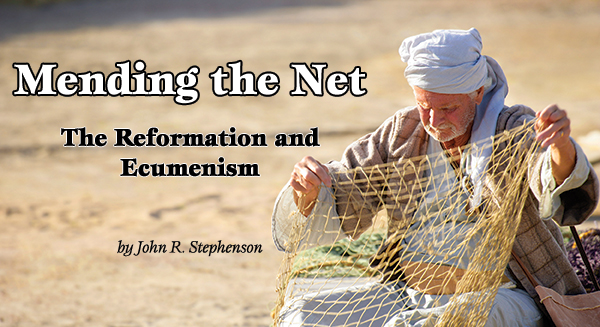Mending the Net: The Reformation and Ecumenism

by John R. Stephenson
When Jesus called them into His service, James and John were sitting in the family fishing boat with their father Zebedee, “mending their nets” (Matthew 4:21). After the Resurrection, seven of the apostles had the frustrating experience of spending a whole night fishing on the Sea of Galilee, catching nothing. As we know, in the early morning the Risen Lord stood on the beach and commanded them to cast their net again, in shallow water and broad daylight. Even though they struggled to bring ashore a miraculous big catch of 153 large fish, St. John mysteriously records that “the net was not torn” (John 21:11).
The Acts of the Apostles record how the Twelve, along with other apostles and ministers, fished people aboard the one Church, which preserved her unity despite the tension that erupted between Jewish and Gentile Christians. We might say that the net remained unbroken in apostolic times. But as early as the second century, rips appeared in the net, the Montanist schism being in some ways a preview of certain aspects of 20th-century Pentecostalism. In the third century, the Novatianist schism occurred when some puritan-minded folk refused to stay in the mainline Church which granted forgiveness even to Christians who committed the worst imaginable sins. The fifth century saw a twofold exodus from the great Church of the Empire, on the part of the “Nestorians” and the “Monophysites” respectively, ancient Christian communities that are still around today. In the lifetime of St. Augustine, most Christians in North Africa belonged to the separatist Donatist Church. The net had suffered multiple rips.
Nor had the full measure of Christian disunity yet been reached. In a process that spanned many centuries, East and West drifted apart, so that between 1053 and 1204 A.D. Eastern Orthodoxy and Western Catholicism gravitated into separate communions. And in the 16th century the Western Catholic Church exploded into a welter of church bodies not in fellowship with each other. In September 1517, Martin Luther accused some leading late medieval theologians of playing down the effects of the Fall and playing up the role sinners could play in securing their own salvation. And on October 31st of that year, the Reformer called for a clean-up of doctrine and practice in the matter of indulgences.
As Luther issued these calls for reform, nothing was further from his mind than to unleash a series of schisms that would lead to the formation of what we now call Roman Catholicism, Lutheranism, Reformed Christianity, the Church of England (which gave birth to Anglicanism), and a variety of Anabaptist groups. In 1530, as Emperor Charles V presided over the Reichstag at Augsburg, there was still one Church, albeit with a great conflict raging within her, while by the time the Formula of Concord was promulgated in 1577, there were at least three distinct churches competing for loyalty within the Holy Roman Empire, possibly more. By now the net had been ripped to shreds.
In many parts of the Western world, Christian division has been such a familiar phenomenon for so long that we oftentimes find it normal and not at all tragic. But I recall, when serving a lengthy vacancy in St. Catharines, visiting an elderly lady from the former Yugoslavia, who expressed regret that the Canadian churches are so aloof and distant from one another. From her girlhood she recalled Roman Catholic, Orthodox, and Lutheran Christians attending each other’s Christmas and Easter services and focusing more on their agreements than on their disagreements. Later in the conversation, she remarked that the area she came from had a large Muslim population!
In many parts of the Western world, Christian division has been such a familiar phenomenon for so long that we oftentimes find it normal and not at all tragic.
By the same token, in many parts of the Third World, Christians of all confessions are a small and sometimes harassed minority surrounded by often hostile adherents of other religions; this is especially the case in India. Even in Canada, we do well to reflect that we call Jesus “our Lord” only within a relatively small circle of our fellow Canadians. Obviously, even though most of these people are not our fellow communicants in Lutheran Church–Canada (LCC), the Holy Spirit has wrought a supernatural bond between them and us. As Canadian secularism becomes ever more threatening and the Muslim presence in our midst grows more menacing, it will become increasingly clear to us that those who confess the universal lordship of Jesus belong together, not apart. It makes sense to do whatever we can to mend the net.
The Ecumenical Movement, as we know it today, got up and running in the second half of the 19th century and enjoyed its glory days in the mid to late 20th century, especially after the Roman Catholic Church leapt aboard its bandwagon at the time of the Second Vatican Council (1962-1965). The long-term goal of the ecumenical movement has always been the attainment of full visible reunion among the separated Christians of the world. One cannot, indeed may not, quibble with this aim. After all, Christ the one Lord brings His people into one Church (or body) through one Baptism, where He wants us to profess one Faith (see Ephesians 4:5 and the surrounding verses). In the upper room, He prayed for unity among His disciples of such a kind that the world will see it (John 17)! Clearly, the mending of the net of His earthly Church is a matter dear to Jesus’ heart.
To put it dangerously crudely, LCC has only a modest investment in the ecumenical movement that is big business for much of Christendom. I recall the tangible excitement of many Christians in the UK in the late 1960s as they expected the goal of visible reunion of the separated churches to be reached within a generation. Many devout people of goodwill suffered much disappointment in the closing decades of the 20th century as the realisation dawned on them that Roman Catholicism, Orthodoxy, confessional Lutheranism, Evangelicalism, and Liberal Protestantism cannot be easily blended into an ecumenical smoothie; Christian doctrine may not be relegated to the adiaphora, that is, to those matters on which we can safely agree to disagree.
Given our strong doctrinal convictions, which have a great impact on the matter of practice, we LCC Lutherans can take a more positive view of the stalled state of ecumenical aspirations than is the case for those who revolve in the orbit of the Lutheran World Federation. Perhaps Christians may never be reunited at a single altar here below, and restoration of broken fellowship is certainly a project for centuries, not decades. In this situation, LCC is cultivating ecumenical relationships with a view to achieving a series of intermediate goals, such as the cultivation of goodwill, praying for and with each other, making common confession of Christian truth wherever possible, cooperating in the relief of suffering, and offering a maximum of joint witness on ethical matters to the militantly secularist authorities of our land.
Clearly, each of our ecumenical partnerships are different, and the area of common ground varies on a case by case basis. We are closest to our brethren of the North American Lutheran Church (NALC), and to the Anglican Church of North America (ACNA), with whom we have established a broad volume of consensus. We are now on the radar screen of the Roman Catholic Church in Canada, some of whose bishops are taking note that the Evangelical Lutheran Church in Canada does not enjoy a monopoly on Lutheranism in this country; our conversations are proceeding well and in a trusting atmosphere, and old caricatures are being overcome on both sides—but we are not going to reach the same point that we have attained with ACNA anytime soon. I have had no involvement in our relations with the Evangelical Fellowship in Canada, but I welcome our efforts to build stronger relationships with this segment of Christendom also.
Each of our seminary courses lists specific goals in the areas of knowledge, attitudes, and skills. As we go about building ecumenical relations at all levels of our churchly life, attitudes are simply crucial. The distinction is often made between polemical and irenical theology, which two adjectives derive from the Greek words for war and peace respectively. The history of doctrine and theology is littered with books consisting of what we might call “punch your lights out polemics” (and I confess to having contributed to this genre of literature myself). But as I represent our Church in conversations with ACNA and the Roman Catholic Church, I do my best to listen, to put the best construction on the words of our dialogue partners, and then to speak the truth in love; it is vital to pray for our separated brothers and sisters and, to the maximum extent possible, with them. Lack of love was responsible for at least some rips in the net.
It is vital to pray for our separated brothers and sisters and, to the maximum extent possible, with them. Lack of love was responsible for at least some rips in the net.
Make no mistake about it: although the conflicts that followed October 31, 1517 soon spiralled out of control and even caused bloodshed over the next two centuries, Martin Luther’s concern was the reform of the one, holy, catholic, and apostolic church, not the multiplication of schism, and his Small Catechism is intended as an irenic, winsome presentation of Christian truth, not as a pharisaic thrusting of “Lutheran” idiosyncrasy in other Christians’ faces. Like James and John at the moment of their call into Jesus’ service, we too should be found doing what we can to mend the net. And yet our efforts as a Synod to mend the net of Christ’s Church are not our chief concern, being a goodly and commendable byway, but not the main highway, which—for all Christian churches and confessions—remains the great task of casting Jesus’ net through the proclamation of His Gospel.
———————
Rev. Dr. John R. Stephenson is Professor of Historical Theology at Concordia Lutheran Theological Seminary in St. Catharines, Ontario.



